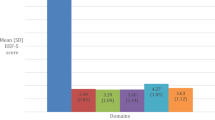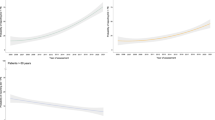Abstract
The availability of adequate treatment for erectile dysfunction (ED) triggers studies into the prevalence of ED in the general population. Yet, previous studies showed different prevalence estimates partly due to differences in patient selection, in (unclear) definitions of ED and in assessment. ENIGMA has been designed to study the prevalence of ED in the general population of The Netherlands, using the WHO definition with a description of the way of assessment. In all, 5721 mail surveys were sent to all men, aged 18 y and older in 12 general practices in The Netherlands. A total of 5601 were included in the study and 2117 (38%) were completed. A total of 38% of the men reported to have ever had some kind of erectile problem. The prevalence of ED was 17% (6% mild, 4% moderate and 7% complete). Age, diabetes, cardiovascular diseases, penile disorders, irradiation in the pelvic region, relational problems, fear for failure, surmenage, medication use and regular consumption of alcohol were independently related to ED. Men with ED were less content with their (sexual) life and had less confidence in sexual performance. Presence of ED was negatively related to affected happiness in life. ED is commonly found in men and is related to age, medication, comorbidity and lifestyle factors. Men with ED perceive a lower quality of (sex)life. Doctors should be aware of the presence of ED and its consequences in patients.
This is a preview of subscription content, access via your institution
Access options
Subscribe to this journal
Receive 8 print issues and online access
$259.00 per year
only $32.38 per issue
Buy this article
- Purchase on Springer Link
- Instant access to full article PDF
Prices may be subject to local taxes which are calculated during checkout


Similar content being viewed by others
References
van Driel MF, van de Wiel HB, Mensink HJ . Some mythologic, religious, and cultural aspects of impotence before the present modern era. Int J Impot Res 1994; 6: 163–169.
Litwin MS, Nied RJ, Dhanani N . Health-related quality of life in men with erectile dysfunction. J Gen Intern Med 1998; 13: 159–166.
Fugl-Meyer AR, Lodnert G, Bränholm IB, Fugl-Meyer KS . On life satisfaction in male erectile dysfunction. Int J Impot Res 1997; 9: 141–148.
Dunn KM, Croft PR, Hackett GI . Sexual problems: a study of the prevalence and need for health care in the general population. Fam Pract 1998; 15: 519–524.
Meuleman EJH et al. Erectiestoornis: prevalentie en invloed op de kwaliteit van leven; het Boxmeer-onderzoek. [Erectile dysfunction: prevalence and effect on the quality of life; Boxmeer study]. Ned Tijdschr Geneesk 2001; 145: 576–581.
Blanker MH et al. Correlates for erectile and ejaculatory dysfunction in older Dutch men: a community-based study. J Am Geriatr Soc 2001; 49: 436–442.
Braun M et al. Epidemiology of erectile dysfuntion: results of the ‘Cologne Male Survey’. Int J Impot Res 2000; 12: 305–311.
Prins J et al. Prevalence of erectile dysfunction: a systematic review of population-based studies. Int J Impot Res 2002; 14: 422–432.
Spector IP, Carey MP . Incidence and prevalence of the sexual dysfunctions: a critical review of the empirical literature. Arch Sex Behav 1990; 19: 389–408.
Bortolotti A, Parazzini F, Colli E, Landoni M . The epidemiology of erectile dysfunction and its risk factors. Int J Androl 1997; 20: 323–334.
Simons JS, Carey MP . Prevalence of sexual dysfunctions: results from a decade of research. Arch Sex Behav 2001; 30: 177–219.
McKinlay JB . The worldwide prevalence and epidemiology of erectile dysfunction. Int J Impot Res 2000; 12(Suppl 4): S6–S11.
Kubin M, Wagner G, Fugl-Meyer AR . Epidemiology of erectile dysfunction. Int J Impot Res 2003; 15: 63–71.
Jardin A et al. 1st International Consultation on Erectile Dysfunction. WHO, ISSIR, SIU, 1999.
NIH Concensus Conference Impotence. NIH concensus development panel on impotence. JAMA 1993; 270: 83–90.
Rosen RC et al. The international index of erectile function (IIEF): a multidimensional scale for assessment of erectile dysfunction. Urology 1997; 49: 822–830.
Speckens AE et al. Discrimination between psychogenic and organic erectile dysfunction: LIST. J Psychsom Res 1993; 37: 135–145.
Jackson G . Erectile dysfunction and cardiovascular disease. Int J Clin Pract 1999; 53: 363–368.
Muller SC, el Damanhoury H, Ruth J, Lue TF . Hypertension and impotence. Eur Urol 1991; 19: 29–34.
Meinhardt W et al. The influence of medication on erectile dysfunction. Int J Impot Res 1997; 9: 17–26.
el Rufaie OE, Bener A, Abuzeid MS, Ali TA . Sexual dysfunction among type II diabetic men: a controlled study. J Psychosom Res 1997; 43: 605–612.
Fedele D et al. Erectile dysfunction in diabetic subjects in Italy. Gruppo Italiano Studio Deficit Erettile nei Diabetici. Diabetes Care 1998; 21: 1973–1977.
Babb RR, Kieraldo JH . Sexual dysfunction after abdominoperineal resection. Am J Dig Dis 1977; 22: 1127–1129.
Soderdahl DW, Knight RW, Hansberry KL . Erectile dysfunction following transurethral resection of the prostate. J Urol 1996; 156: 1354–1356.
Incrocci L, Slob AK, Levendag PC . Sexual (dys)function after radiotherapy for prostate cancer: a review. Int J Radiat Oncol Biol Phys 2002; 52: 681–693.
Gibson GR . Impotence following fractured pelvis and ruptured urethra. Br J Urol 1969; 41: 602.
Sharlip I . Is smoking an independent risk factor for erectile dysfunction? Int J Impot Res 2001; 13(Suppl 5): S51.
Mc Vary KI, Carrier S, Wessells H . Smoking and erectile dysfunction, evidence based analysis. J Urol 2001; 166: 1624–1632.
Seidman S, Roose SP . The relationship between depression and erectile dysfunction. Curr Psychiatry Rep 2002; 2: 201–205.
Rosen RC, Lane RM, Menza M . Effects of SSRIs on sexual function: a critical review. J Clin Psychopharmacol 1999; 19: 67–85.
Author information
Authors and Affiliations
Corresponding author
Appendix
Appendix
Questions on erectile (dys)function*
-
1
Have you ever noticed that your penis did not get rigid, while you wanted it to be (during sexual activity, for instance if you wanted to have intercourse)? Yes/No/I do not remember
-
2
If yes is it still present at the moment? Yes/No
-
3
How long ago did it start? 1–3 weeks/1–3 months/4–6 months/7–12 months/1–5 y/more than 5 y
-
4
How long did it last? 1–3 weeks/1–3 months/4–6 months/7–12 months/1–5 y/more than 5 y
-
5
How often did it happen or does it happen? (almost) every time, most of the times, as many times yes as no/seldom/(almost) never
-
6
How much do you get bothered by it? Very much/much/moderate/little, not at all
-
7
Were you less in the mood for sex in the last half year? Yes/No
-
8
Are there any circumstances in which the penis does not get rigid? Yes/No
-
9
Did you masturbate the last half year? Yes/No
-
10
If yes, is the penis getting rigid enough (more than 50%) during masturbation? Yes/No
-
11
If not, how often does the penis get insufficient rigid? (Almost) always/most of the times/as often yes as no/seldom/(almost) never
-
12
Did the penis ever get not sufficient rigid during sexual activity? This means; there was sufficient stimulation and some form of rigidity, but not sufficient for a fulfilling sexual activity (for instance for sexual intercourse)? Yes/No/I do not remember
-
13
Did the complaint start suddenly or more slowly? During weeks/during months
-
14
If yes is it still present at the moment? Yes/No
-
15
How long ago did it start? 1–3 weeks/1–3 months/4–6 months/7–12 months/1–5 y/more than 5 y
-
16
How long did it last? 1–3 weeks/1–3 months/4–6 months/7–12 months/1–5 y/more than 5 y
-
17
How often did it happen or does it happen? (almost) every time/most of the times/as many times yes as no/seldom/(almost) never
-
18
How much do you get bothered by it? Very much/much/moderate/little/not at all
-
19
Did the penis remain shorter rigid than you wanted? Yes/no/I do not remember
-
20
How difficult was it to maintain your erection until the end of the sexual activity (for instance during sexual intercourse)? Did not try/very difficult/difficult/a little difficult/not very difficult/not at all difficult
-
21
Is it still present at the moment? Yes/No
-
22
How long ago did it start? 1–3 weeks/1–3 months/4–6 months/7–12 months/1–5 y/more than 5 y
-
23
How long did it last? 1–3 weeks/1–3 months/4–6 months/7–12 months/1–5 y/more than 5 y
-
24
How often did it happen or does it happen? (almost) every time, most of the times, as many times yes as no/seldom/(almost) never
-
25
How much do you get bothered by it? Very much/much/moderate/little, not at all
-
26
Do you notice any spontaneous erections, in the night or while waking up? Always/most of the times/sometimes/seldom/never
-
27
How often during the last half year did you notice that? Never/once a month or less/more than once a month
-
28
How rigid was the penis at most during last half year in the night or during waking up? 50% or less/more than 50%
-
29
How strong is your confidence to obtain or maintain an election during sexual activity? Very strong/strong/more or less/weak/very weak or absent
*Originally in Dutch, translated into English.
ED (according to the definition of WHO)=(Q1: yes and Q2: yes and Q5: excluding seldom and (almost) never) or (Q12: yes and Q14: yes and Q11: excluding seldom and (almost never)) or (Q19: yes and Q21: yes and Q24: except for little and not at all) and (Q20: very difficult–little difficult).
Rights and permissions
About this article
Cite this article
de Boer, B., Bots, M., Lycklama a Nijeholt, A. et al. Erectile dysfunction in primary care: prevalence and patient characteristics. The ENIGMA study. Int J Impot Res 16, 358–364 (2004). https://doi.org/10.1038/sj.ijir.3901155
Received:
Revised:
Accepted:
Published:
Issue Date:
DOI: https://doi.org/10.1038/sj.ijir.3901155
This article is cited by
-
Let’s talk about sex: exploring factors influencing the discussion of sexual health among chronically Ill patients in general practice
BMC Primary Care (2022)
-
Prevalence of use of erectile dysfunction medication by Dutch military personnel between 2003 and 2012
International Journal of Impotence Research (2017)
-
Evaluation of Sexual Dysfunction in Males with Diabetes
Sexuality and Disability (2015)
-
Sexual Function and Problems with Adolescents and Young Adults
Current Sexual Health Reports (2015)
-
Influence of socio-demographic characteristics on prevalence of erectile dysfunction in Nigeria
International Journal of Impotence Research (2013)



